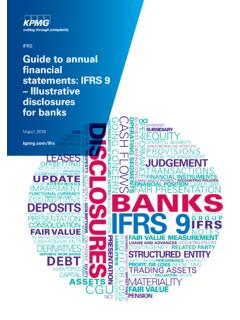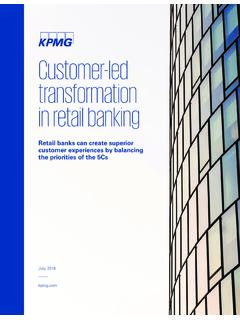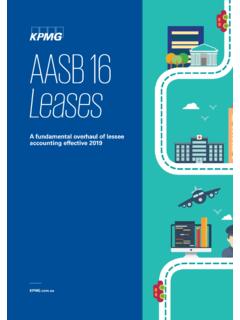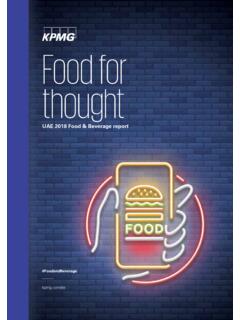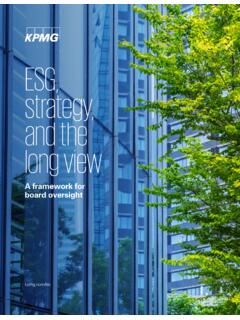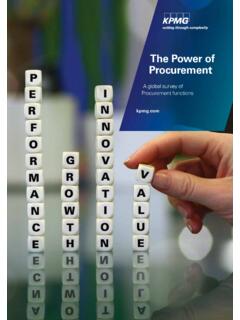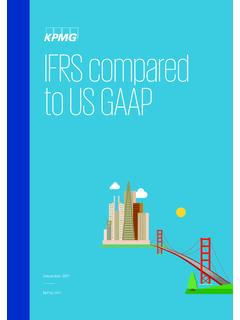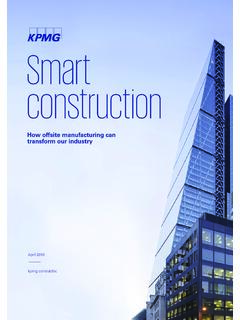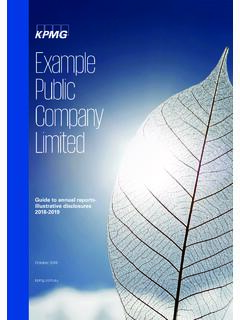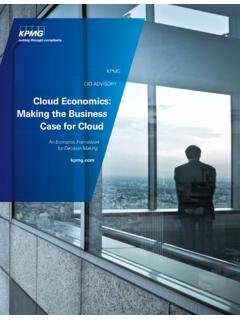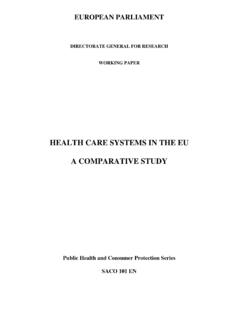Transcription of Lease components
1 Lease componentsThe unit of account for Lease accountingIFRS 16 September challenges 11 at a glance Key facts Key impacts 32 Identifying separate Lease components Combining contracts Separate Lease components Lessors Additional considerations for land and buildings Portfolio approach 143 Identifying non- Lease components Non- Lease components Practical expedient for lessees Combining Lease and non- Lease components 204 Allocating the consideration Contract consideration Allocation of consideration Lessor allocation Lessee allocation Allocation of variable consideration 375 Reallocating the consideration Modification of contracts Remeasurement of Lease payments 45 Appendix I IFRS 16 at a glance 52 Appendix II List of examples 53 About this publication 55 Keeping in touch 56 2019 KPMG IFRG Limited, a UK company, limited by guarantee.
2 All rights challengesLease agreements frequently bundle multiple components from complex outsourcing arrangements, to simple real estate leases in which the landlord provides building maintenance. If your business has leases, you will probably face component questions when implementing IFRS 16 Leases. The Lease component is the unit of account for Lease accounting. Lessors and lessees need to identify, and generally separate, Lease and non- Lease components to apply the new standard. To do this, they need to allocate the consideration in the contract between the components that they account for separately. For a lessor, this process is necessary to correctly distinguish Lease income from other revenue. Lessors generally apply IFRS 15 Revenue from Contracts with Customers to do a lessee, this process has a more fundamental accounting impact it determines what proportion of a contract will be recognised on-balance sheet.
3 The new standard has specific guidance on how to determine this. This publication contains practical guidance and examples showing how to identify Lease and non- Lease components in a contract and how to allocate the consideration. We hope you will find it useful as you apply the new BascomRamon JubelsSylvie LegerBrian O DonovanKPMG s global IFRS leases leadership teamKPMG International Standards Group 2019 KPMG IFRG Limited, a UK company, limited by guarantee. All rights | Lease components 1 At a Key facts The Lease component is the unit of account for Lease accounting. Lessors and lessees separate Lease components from other Lease components and, generally, from non- Lease components such as services. They then allocate and, if necessary, reallocate the consideration in the contract between the components that they account for separately.
4 The key steps in accounting for the components of a contract are as follows. Identify separate Lease components (see)Chapter 2 Identify non- Lease components (see)Chapter 3 Allocate consideration (see)Chapter 4 Reallocate consideration on Lease modification orreassessment (see)Chapter 5 A lessor applies IFRS 15 to separate components . A lessee applies specific guidance in the new standard that is similar to, but less detailed than, IFRS 15. For lessees only, a practical expedient allows a Lease and associated non- Lease components to be accounted for as a single Lease component rather than separately (see Section ). Otherwise, Lease components and non- Lease components are always separated, with non- Lease components accounted for under other standards.
5 Once the Lease and non- Lease components have been identified and separated, the lessee allocates the contract consideration to each Lease component on the basis of its stand-alone price and the aggregate stand-alone prices of the non- Lease components . All of this is done at the beginning of a contract, so that each Lease component can be accounted for from its commencement date. In addition, if a contract is modified, or the new standard requires the Lease payments to be reassessed, then subsequent reallocations may be necessary (see Chapter 5). 2019 KPMG IFRG Limited, a UK company, limited by guarantee. All rights at a glance | Key impacts | Key impacts Distinguishing Lease income from other revenue. For lessors, identifying components and allocating consideration will determine the split of Lease income vs revenue from contracts with customers.
6 These amounts are often presented, and must be disclosed, separately. For example, a real estate company will need to distinguish Lease income from revenue for other building-related services common area maintenance (CAM). Determining what proportion of a contract will be on-balance sheet. For lessees, distinguishing between Lease components (generally on-balance sheet) and non- Lease components (generally off-balance sheet) will be a key driver of the impact of the new standard. This will also require careful allocation of consideration between components . Deciding whether to apply the practical expedient. Lessees will need to decide whether, and if so when, to apply the practical expedient to combine a Lease component with associated non- Lease components .
7 This decision must be made separately for each class of underlying asset. Applying the practical expedient will generally simplify application of the new standard but when payments are fixed, this will increase reported assets and liabilities, and impact many financial ratios. Identifying components and gathering information. This may require a substantial effort to identify all components , gather information on the stand-alone prices and allocate the consideration on commencement, reassessment and modification of the Lease . New estimates and judgements. The new standard introduces new estimates and judgements that affect the measurement of Lease liabilities. A lessee determines the liability at commencement and may be required to remeasure it remeasurement of the Lease components on a reassessment or modification.
8 This will require ongoing monitoring and increase financial statement volatility. Balance sheet volatility. The new standard introduces financial statement volatility to assets and liabilities for lessees and lessors, due to the requirements to account for reassessment and Lease modifications. This may impact a company s ability to accurately predict and forecast results and will require ongoing monitoring. Changes in contract terms and business practices. The impact of the new standard is not limited only to financial reporting. It may prompt changes to certain contract terms and business practices changes in the structuring or pricing of a Lease agreement, including the type of variability of Lease payments and the inclusion of options in the contract.
9 The new standard is likely to affect departments beyond financial reporting including treasury, tax, legal, procurement, real estate, budgeting, sales, internal audit and IT. New systems and processes. Companies should ensure that they have systems and processes that enable them to identify separate Lease and non- Lease components and gather information for allocating consideration to comply with the requirements. Careful communication with stakeholders. Investors and other stakeholders will want to understand the new standard s impact on the business. Areas of interest may include the effect on financial position and financial results, the costs of implementation and any proposed changes to business practices. Sufficient documentation.
10 The judgements, assumptions and estimates applied in determining how to measure the Lease liability at the commencement date, as well as remeasurement when a reassessment or modification occurs, will need to be documented. 2019 KPMG IFRG Limited, a UK company, limited by guarantee. All rights | Lease components 2 Identifying separate Lease components Each separate Lease component is a unit of account to be accounted for under the new , B2, B32, BC130 When a company concludes that a contract is or contains a Lease , it identifies each separate Lease component, which is the unit of account under the new standard. However, before setting out to identify and separate Lease components , it is important to establish whether the new standard requires you to assess a single contract or a combination of contracts.
